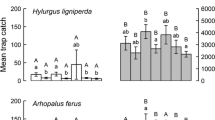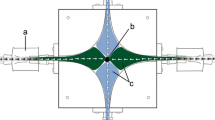Abstract
Xylosandrus germanus (Blandford), a species native to Asia but currently invading North American and European forests, exploits living, but weakened trees. In response to many sources of stress, trees emit ethanol, which represents an important host-location cue for X. germanus. Because stressed trees can be spatially and temporally variable over a landscape, we assessed the role of olfaction in aiding X. germanus to efficiently locate vulnerable trees during natural dispersal. We conducted a series of experiments and observed that attacks occurred on trees baited with ethanol, but immediately ceased upon removal of the ethanol cue. X. germanus also efficiently located and attacked ethanol-injected trees, but rarely landed on adjacent trees not emitting ethanol, and never attacked these neighboring trees. A spatial analysis of trees attacked by ambrosia beetles within diverse landscapes revealed that only certain host species or cultivars, and only certain individuals within these host species or cultivars, were attacked; ethanol was also detected in the attacked trees, but not in non-attacked trees. Thus, X. germanus uses an efficient olfactory mechanism while orienting among perceived non-hosts to specifically locate trees associated with ethanol. Combined with other attributes, we propose that the remarkable efficiency by which this non-native ambrosia beetle uses volatile cues to locate specific vulnerable hosts across a diverse landscape aids its successful establishment and population spread.



Similar content being viewed by others
References
Aukema JE, McCullough DG, Von Holle B, Liebhold AM, Britton K, Frankel SJ (2010) Historical accumulation of nonindigenous forest pests in the continental US. BioSci 60:886–897
Bartelt RJ (1997) Calibration of a commercial solid-phase microextraction device for measuring headspace concentrations of organic volatiles. Anal Chem 69:364–372
Bjørnstad ON (2012) Package ‘ncf.’ Spatial nonparametric covariance functions. http://cran.r-project.org/web/packages/ncf/. Accessed 28 May 2013
Bjørnstad ON, Falck W (2001) Nonparametric spatial covariance functions: estimating and testing. Environ Ecol Stat 8:53–70
Boerner REJ, Runge SD, Cho D-S, Kooser JG (1988) Localized ice storm damage in an Appalachian plateau watershed. Am Mid Nat 119:199–208
Brand MH (2002) UConn plant database. http://www.hort.uconn.edu/plants/. Accessed 28 May 2013
Bright DE (2014) A catalog of Scolytidae and Platypodidae (Coleoptera), supplement 3 (2000–2010), with notes on subfamily and tribal reclassifications. Insecta Mundi 356:1–336
Brockerhoff EG, Bain J, Kimberley M, Knížek M (2006) Interception frequency of exotic bark and ambrosia beetles (Coleoptera: Scolytinae) and relationship with establishment in New Zealand and worldwide. Can J For Res 36:289–298
Bruce TJA, Wadhams LJ, Woodcock CM (2005) Insect host location: a volatile situation. Trends Plant Sci 10:269–274
CABI/EPPO (2008) Xylosandrus germanus. Distribution maps of plant pests no. 715. CABI Head Office, Wallingford, UK. http://www.cabi.org/dmpp/FullTextPDF/2008/20083279221.pdf. Accessed 30 Oct 2013
Cappiello PE, Littlefield LE (1994) Woody landscape plant cold-hardiness ratings. Maine Agric For Exp Stn Tech Bull 156: 41
Cubasch U, Waszkewitz J, Hegerl G, Perlwitz J (1995) Regional climate changes as simulated time-slice experiments. Clim Change 31:273–304
Dole SA, Jordal BH, Cognato AI (2010) Polyphyly of Xylosandrus Reitter inferred from nuclear and mitochondrial genes (Coleoptera: Curculionidae: Scolytinae). Mol Phylogenet Evol 54:773–782
Dunbar DM, Stephens GR (1975) Association of two-lined chestnut borer and shoestring fungus with mortality of defoliated oak in Connecticut. For Sci 22:169–174
Dunn JP, Kimmerer TW, Nordin GL (1986) The role of host tree condition in attack of white oaks by the twolined chestnut borer, Agrilus bilineatus (Weber) (Coleoptera: Buprestidae). Oecologia 70:596–600
Easterling DR, Meehl GA, Parmesan C, Changnon SA, Karl TR, Mearns LO (2000) Climate extremes: observations, modeling, and impacts. Science 289:2068–2074
Feeny P (1976) Plant apparency and chemical defense. In: Wallace JW, Mansell RL (eds) Biochem. Inter. between plants and insects. Rec. Adv. in Phytochem. Plenum Press, New York, pp 3–19
Felt EP (1932) A new pest in greenhouse grown grape stems. J Econ Entomol 25:2
Forney CF, Jordan MA, Nicholas KUKG, Deell JR (2000) Volatile emissions and chlorophyll fluorescence as indicators of freezing injury in apple fruit. HortSci 35:1283–1287
Fraedrich SW, Harrington TC, Rabaglia RJ, Ulyshen MD, Mayfield AE III, Hanula JL, Eickwort JM, Miller DR (2008) A fungal symbiont of the redbay ambrosia beetle causes a lethal wilt in redbay and other Lauraceae in the southeastern USA. Plant Dis 92:215–224
Grégoire J-C, Piel F, De Proft M, Gilbert M (2001) Spatial distribution of ambrosia-beetle catches: a possibly useful knowledge to improve mass-trapping. Integ Pest Manag Rev 6:237–242
Hanks LM (1999) Influence of the larval host plant on reproductive strategies of cerambycid beetles. Annu Rev Entomol 44:483–505
Henin JM, Versteirt V (2004) Abundance and distribution of Xylosandrus germanus (Blandford 1894) (Coleoptera, Scolytidae) in Belgium: new observations and an attempt to outline its range. J Pest Sci 77:57–63
Hulcr J, Dunn RR (2011) The sudden emergence of pathogenicity in insect-fungus symbioses threatens naive forest ecosystems. Proc R Soc B Biol Sci 278:2866–2873
Kelsey RG (2001) Chemical indicators of stress in trees: their ecological significance and implication for forestry in eastern Oregon and Washington. Northwest Sci 75:70–76
Kelsey RG, Joseph G (2001) Attraction of Scolytus unispinosus bark beetles to ethanol in water-stressed Douglas fir branches. For Ecol Manag 144:229–238
Kelsey RG, Beh MM, Shaw DC, Manter DK (2013) Ethanol attracts scolytid beetles to Phytophthora ramorum cankers on coast live oak. J Chem Ecol 39:494–506
Kharin VV, Zwiers FW (2005) Estimating extremes in transient climate change simulations. J Clim 18:1156–1173
Kimmerer TW, Kozlowski TT (1982) Ethylene, ethane, acetaldehyde, and ethanol production by plants under stress. Plant Physiol 69:840–847
Kirkendall LR (1993) Ecology and evolution of biased sex ratios in bark and ambrosia beetles (Scolytidae). In: Wrensch DL, Ebbert MA (eds) Evolution and diversity of sex ratio: insects and mites. Chapman and Hall, New York, pp 235–345
Klimetzek D, Köhler J, Vité JP, Kohnle U (1986) Dosage response to ethanol mediates host selection by “secondary” bark beetles. Naturwissenschaften 73:270–272
Koch FH, Smith WD (2008) Spatio-temporal analysis of Xyleborus glabratus (Coleoptera: Circulionidae: Scolytinae) invasion in eastern US forests. Environ Entomol 37:442–452
Kühnholz S, Borden JH, Uzunovic A (2001) Secondary ambrosia beetles in apparently healthy trees: adaptations, potential causes and suggested research. Int Pest Manag Rev 6:209–219
Kunkel KE, Andsager K, Easterling DR (1999) Long-term trends in extreme precipitation events over the conterminous United States and Canada. J Clim 12:2515–2527
La Spina S, De Canniére C, Dekri A, Grégoire J-C (2013) Frost increases beech susceptibility to scolytine ambrosia beetles. Agric For Entomol 15:157–167
Liebhold AM, Brockerhoff EG, Garrett LJ, Parke JL, Britton KO (2012) Live plant imports: the major pathway for forest insect and pathogen invasions of the US. Front Ecol Environ 10:135–143
Mokrzycki T, Hilszczański J, Borowski J, Cieślak R, Mazur A, Miłkowski M, Henryk S (2011) Faunistic review of Polish Platypodinae and Scolytinae (Coleoptera: Curculionidae). Pol J Entomol/Pol Pismo Entomol 80:343–364
Motzkin G, Ciccarello SC, Foster DR (2002) Frost pockets on a level sand plain: does variation in microclimate help maintain persistent vegetation patterns? J Torrey Bot Soc 129:154–163
Nageleisen LM (1994) Le dépérissement actuel de feuillus divers: hétre, merisier, alisier terminal, érable sycomore, peuplier, châtaignier, charme, aulne glutineux. Revue Forestiere Francaise 46:554–562
NOAA (2012) National Oceanic and Atmospheric Administration, National Climatic Data Center, State of the Climate: National Overview for April 2012. http://www.ncdc.noaa.gov/sotc/national/2012/4. Accessed 28 May 2013
Normark BB, Jordal BH, Farrell BD (1999) Origin of a haplodiploidy beetle lineage. Proc R Soc Lond B 266:2253–2259
Obenland DM, Aung LH, Bridges DL, Mackey BE (2003) Volatile emissions of navel oranges as predictors of freeze damage. J Agric Food Chem 51:3367–3371
Peer K, Taborsky M (2005) Outbreeding depression, but no inbreeding depression in haplodiploid ambrosia beetles with regular sibling mating. Evolution 59:317–323
Ploetz RC, Hulcr J, Wingfield MJ, de Beer ZW (2013) Destructive tree diseases associated with ambrosia and bark beetles: black swan events in tree pathology? Plant Dis 95:856–872
Rabaglia RJ, Dole SA, Cognato AI (2006) Review of American Xyleborina (Coleoptera: Curculionidae: Scolytinae) occurring North of Mexico, with an illustrated key. Ann Entomol Soc Am 99:1034–1055
Ranger CM, Reding ME, Persad AB, Herms DA (2010) Ability of stress-related volatiles to attract and induce attacks by Xylosandrus germanus and other ambrosia beetles (Coleoptera: Curculionidae, Scolytinae). Agric For Entomol 12:177–185
Ranger CM, Reding ME, Gandhi KJK, Oliver JB, Schultz PB, Cañas L, Herms DA (2011) Species dependent influence of (−)-α-pinene on attraction of ambrosia beetles to ethanol-baited traps in nursery agroecosystems. J Econ Entomol 104:574–579
Ranger CM, Reding ME, Schultz PB, Oliver JB (2012) Ambrosia beetle (Coleoptera: Curculionidae) responses to volatile emissions associated with ethanol-injected Magnolia virginiana L. Environ Entomol 41:636–647
Ranger CM, Reding ME, Schultz PB, Oliver JB (2013) Influence of flood-stress on ambrosia beetle host selection and implications for their management in a changing climate. Agric For Entomol 15:56–64
R Development Core Team (2005) R: a language and environment for statistical computing. R Foundation for Statistical Computing, Vienna. ISBN 3-900051-07-0
Reding ME, Oliver J, Schultz P, Ranger CM (2010) Monitoring flight activity of ambrosia beetles in ornamental nurseries with ethanol-baited traps: influence of trap height on captures. J Environ Hortic 28:85–90
Reding ME, Schultz PB, Ranger CM, Oliver JB (2011) Optimizing ethanol-baited traps for monitoring damaging ambrosia beetles (Coleoptera: Curculionidae, Scolytinae) in ornamental nurseries. J Econ Entomol 104:2017–2024
Reding ME, Ranger CM, Oliver JB, Schultz PB (2012) Monitoring attack and flight activity of Xylosandrus spp. (Coleoptera: Curculionidae: Scolytinae); the influence of temperature on activity. J Econ Entomol 4:1780–1787
Reed SM (2005) Japanese snowbell exhibits variability for time of vegetative budbreak and susceptibility to spring freeze damage. HortSci 40:542–545
Romeo JT (2009) New SPME guidelines. J Chem Ecol 35:1383
Saint-Germain M, Buddle CM, Drapeau P (2007) Primary attraction and random landing in host-selection by wood-feeding insects: a matter of scale? Agric For Entomol 9:227–235
SAS Institute (2001) PROC user’s manual, version 6. SAS Institute, Cary
Solomon JD (1995) Guide to insect borers in North American broadleaf trees and shrubs. U.S. Department of Agriculture-Forest Service, Washington, DC
Timlin M, Umphlett N, Shulski M, Todey D, Eise J, Anderson C (2012) March heat, April freezes. http://www.crh.noaa.gov/images/crh/climate/MarchHeatAprilFreeze.pdf. Accessed 28 May 2013
Visser JF (1986) Host odor perception in phytophagous insects. Annu Rev Entomol 31:121–144
Weber BC, McPherson JE (1983) World list of host plants of Xylosandrus germanus (Blandford) (Coleoptera: Scolytidae). Coleop Bull 37:114–134
Weber BC, McPherson JE (1984) Attack on black walnut trees by the ambrosia beetle Xylosandrus germanus (Coleoptera: Scolytidae). For Sci 30:864–870
Wood DL (1982) The role of pheromones, kairomones, and allomones in the host selection and colonization of bark beetles. Annu Rev Entomol 27:411–446
Zach P, Topper W, Kulfan J, Simon M (2001) Colonization of two alien ambrosia beetles (Coleoptera, Scolytidae) on debarked spruce logs. Biologia (Bratislava) 56:175–181
Zwiers FW, Kharin VV (1998) Changes in the extremes of the climate simulated by CCC GCM2 under CO2 doubling. J Climate 11:2200–2222
Acknowledgments
This research was supported in part by funding from the USDA Floriculture and Nursery Research Initiative and base funds associated with ARS Research Project 3607-22000-012-00D (National Program 304-Crop Protection and Quarantine). We thank James Moyseenko, Jennifer Barnett, Betsy Anderson, and Leslie Morris for technical assistance. We also thank anonymous reviewers for useful comments. Mention of proprietary products or companies does not imply any endorsement or preferential treatment by the USDA-Agricultural Research Service, USDA-Forest Service, or The Ohio State University.
Author information
Authors and Affiliations
Corresponding author
Electronic supplementary material
Below is the link to the electronic supplementary material.
Rights and permissions
About this article
Cite this article
Ranger, C.M., Tobin, P.C. & Reding, M.E. Ubiquitous volatile compound facilitates efficient host location by a non-native ambrosia beetle. Biol Invasions 17, 675–686 (2015). https://doi.org/10.1007/s10530-014-0758-2
Received:
Accepted:
Published:
Issue Date:
DOI: https://doi.org/10.1007/s10530-014-0758-2




